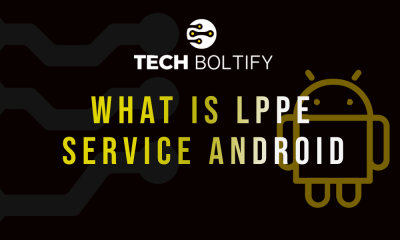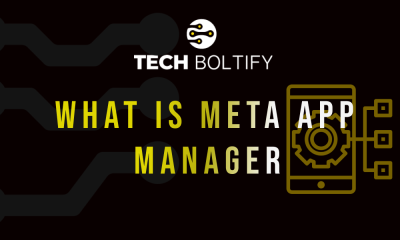Tech
Sustainable Manufacturing Automation: Reducing Waste and Energy Consumption
Want to slash your manufacturing waste while cutting energy costs?
Every manufacturer today is facing the same brutal challenge. You need to stay competitive while reducing your environmental impact. The good news?
Manufacturing automation isn’t just about efficiency anymore…
It’s becoming the secret weapon for sustainable operations.
Here’s what makes this even better…
Companies that embrace automated manufacturing processes are seeing dramatic results. A recent Deloitte study shows that 62% of manufacturers planned to use robotics and automation to improve efficiency in 2023.
But here’s the kicker:
Those choosing to automate saw a 30% higher average growth rate than businesses relying on manual processes.
What you’ll discover:
- Why Manufacturing Automation Is Your Sustainability Secret Weapon
- The Real Cost of Energy Waste in Manufacturing
- Smart Technologies That Cut Waste and Energy Consumption
- How AI and IoT Are Revolutionizing Green Manufacturing
Why Manufacturing Automation Is Your Sustainability Secret Weapon
Manufacturing automation is completely transforming how companies approach sustainability.
Here’s the thing: Traditional manufacturing processes are absolute energy hogs. Industry accounts for about one-third of all CO2 pollution, and the numbers are staggering when you look at waste.
But automation changes everything…
Smart manufacturing systems don’t just work faster—they work smarter. By integrating advanced Omega AI technologies into manufacturing automation systems, companies can monitor, analyze, and optimize every aspect of their production processes in real-time.
This means:
- Precise resource allocation: Automated systems use exactly what’s needed, when it’s needed
- Predictive maintenance: Equipment runs optimally and fails way less often
- Real-time monitoring: Instant detection of energy waste and inefficiencies
Consider this: 58% of manufacturers believe sustainability is essential to remain competitive.
They’re not wrong—sustainability isn’t just good for the planet anymore…
It’s becoming a business necessity.
The Real Cost of Energy Waste in Manufacturing
Let me show you something that’s going to shock you…
The U.S. manufacturing sector wastes more energy than it uses effectively. According to energy efficiency reports, a staggering 58% of energy is completely wasted.
That’s literally throwing money down the drain.
Think about what this means for your bottom line:
- Unnecessarily high utility bills
- Excessive carbon emissions
- Inefficient production processes
- Lost competitive advantage
But here’s where manufacturing automation becomes your game-changer…
Automated production lines optimize efficiency by minimizing human error, reducing downtime, and streamlining manufacturing processes. Companies implementing AI-powered energy management systems are seeing remarkable results.
Here’s a real example: One automotive manufacturer reduced energy consumption by 15% without any impact on output—simply by using smart systems to identify inefficiencies and adjust equipment settings in real-time.
Pretty impressive, right?
Smart Technologies That Cut Waste and Energy Consumption
Want to know the technologies that are making the biggest impact?
Let me break it down for you…
AI-Powered Predictive Analytics
Artificial intelligence isn’t just a buzzword anymore—it’s revolutionizing sustainable manufacturing.
AI systems analyze vast amounts of production data to predict when equipment will need maintenance, optimize energy usage patterns, and identify waste before it happens.
Here’s another real example: A large food processing company used machine learning to predict energy demand peaks and adjust production schedules accordingly.
The result? They took advantage of lower off-peak energy rates and reduced overall energy consumption by significant margins.
Industrial Internet of Things (IIoT)
Connected sensors and devices are creating smart factories that can monitor every aspect of production. These IIoT systems continuously monitor energy consumption at the machine level, identifying and correcting inefficiencies in real-time.
Here’s what one aerospace manufacturer achieved: They saw a 10% reduction in energy costs and a 15% improvement in overall equipment effectiveness after implementing IIoT-enabled energy management across their facilities.
Advanced Robotics and Automation
Modern robots do way more than just replace human workers—they optimize every single movement and process. Predictions show that 600,000 automation units will be installed globally this year alone, with many focusing specifically on sustainability improvements.
Automated production lines reduce waste by:
- Precision control: Exact material measurements and minimal overconsumption
- Quality consistency: Fewer defective products that end up as waste
- Optimized workflows: Smoother processes with fewer energy-intensive stops and starts
How AI and IoT Are Revolutionizing Green Manufacturing
The integration of AI and IoT technologies is creating unprecedented opportunities for sustainable manufacturing.
Here’s how it works:
Smart sensors can automatically control machinery and processes to limit energy consumption. These devices turn off machines that aren’t in use and collect data that measures efficiency, giving operators insights to adjust settings for optimal energy use.
Computer vision technology monitors inventory, products, and processes without additional sensors. It can assess production and find operations that don’t fit within acceptable time, quality, or quantity limits.
But here’s what most manufacturers don’t realize…
The biggest wins come from combining these technologies. When AI, IoT, and automation work together, they create a manufacturing ecosystem that continuously optimizes itself for both efficiency and sustainability.
It’s like having a self-improving factory.
Waste Heat Recovery Systems
Smart manufacturers are capturing and repurposing waste heat from their processes.
Here’s a perfect example: A brewery in Colorado implemented a waste heat recovery system that captures thermal energy from brewing and uses it to preheat water for subsequent cycles, reducing natural gas consumption by 20%.
Renewable Energy Integration
Automated systems can seamlessly integrate with renewable energy sources. Solar-powered manufacturing facilities are becoming more common, with some achieving 80% of their energy needs from on-site renewable generation during peak production hours.
The benefits are obvious: Lower energy costs, reduced carbon footprint, and enhanced brand reputation.
Making the Switch to Sustainable Manufacturing Automation
The transition to sustainable manufacturing automation doesn’t have to be overwhelming.
Here’s exactly what you need to do:
Step 1: Assess your current energy usage – Use automated monitoring systems to establish baselines and identify the biggest waste sources.
Step 2: Implement smart sensors – Begin with basic IoT devices that monitor energy consumption and equipment performance.
Step 3: Invest in predictive maintenance – AI-powered systems that prevent equipment failures and optimize performance.
Step 4: Optimize production scheduling – Use automation to run energy-intensive processes during off-peak hours when electricity is cheaper.
Here’s the key: You don’t have to automate everything at once. Many successful manufacturers start with one production line or process, prove the ROI, and then scale up.
It really is that simple.
The Future Is Automated and Sustainable
Manufacturing automation isn’t just about staying competitive anymore—it’s about building a sustainable future for your business and the planet.
Companies that embrace these technologies now are positioning themselves for long-term success. They’re cutting costs, reducing waste, minimizing their environmental impact, and often discovering that sustainable practices actually improve their bottom line.
The statistics don’t lie: automated manufacturing processes deliver measurable results in both efficiency and sustainability. With energy costs rising and environmental regulations tightening, there’s never been a better time to make the switch.
The question isn’t whether you should invest in sustainable manufacturing automation—it’s exactly how quickly you can get started. The future of truly successful manufacturing depends on making this critical transition today.
Tech
Chargebacks and Friendly Fraud: The Hidden Cost Marketers Keep Ignoring
Hyper-focused on conversions, ROI, and audience segmentation are on the rise, and a silent profit killer is, in most cases, unnoticed: chargebacks and friendly fraud.
We could easily agree that ad budgets receive all the attention, but what happens after the sale, when a customer disputes a legitimate transaction, can be just as important to long-term revenue, in fact, for many eCommerce businesses, SaaS providers, and subscription platforms, chargebacks are quietly merging into margins and trust that marketing teams often miss.
Marketers may unintentionally, without recognizing it themselves, create the problem.
Let’s break down how chargebacks and friendly fraud work, why they matter more than most marketers realize, and how tools like authentication and modern ID verification services can mitigate losses and protect both reputation and revenue.
Understanding Chargebacks
A chargeback occurs when a cardholder contacts their bank to dispute a transaction rather than going to the merchant for a refund, and then the bank investigates the claim, and if the dispute is upheld, the merchant is forced to return the funds, plus a processing fee.
Chargebacks were initially designed as a consumer protection mechanism, particularly for cases involving stolen cards or unauthorized charges:
- True fraud: Actual unauthorized transactions (e.g., stolen credit cards)
- Merchant error: Duplicate charges, unclear billing descriptors, or unfulfilled orders
- Friendly fraud: A customer knowingly files a false chargeback after receiving goods/services
Actual fraud and merchant error are relatively straightforward to address; however, friendly fraud is deceptive, costly, and rising fast.
What Is Friendly Fraud?
Friendly fraud occurs when a customer disputes a legitimate charge, either due to a misunderstanding, forgetfulness, or intentional abuse. Common scenarios include:
- Claiming they did not receive an item, they actually did
- Forgetting about a subscription renewal and calling it unauthorized
- Attempting to get a “free product” through a chargeback
- Disputing a purchase made by a family member without their knowledge
It might seem like a customer service issue, but its impact is far greater.
Why Marketers Should Care About Chargebacks
If you are in growth or performance marketing, chargebacks might not fall under your typical KPIs. But ignoring them has risks:
They Directly Undermine Your ROI
You might be driving top-performing campaigns and lowering CAC, but if a high percentage of those customers end up filing chargebacks, the actual revenue is lower than reported. Worse, chargebacks are not just refunds – they include fees and potential lost inventory.
Every invalid transaction essentially becomes a negative ROI.
- They Hurt Brand Trust and User Experience
If the user’s journey is unclear, especially post-purchase, users are more likely to assume fraud or take complaints to their bank. Ambiguity in receipts, subscription terms, or delivery expectations can fuel unnecessary disputes.
They Threaten Platform Standing
Excessive chargebacks put your merchant account at risk. Payment processors monitor chargeback rates closely, and if you exceed limits (typically ~1%), you could face:
- Higher processing fees
- Account freezes
- Being placed in a chargeback monitoring program
- Total payment gateway suspension
For marketing teams that rely on seamless checkout experiences, that is a disaster scenario.
- They Waste Valuable Resources
Every chargeback means a manual review, customer support time, and often third-party intervention. If the marketing campaign brings in leads that turn into fraud headaches, you are creating operational drag for your own team and others downstream.
What Causes Friendly Fraud?
The roots of friendly fraud often lie in a combination of communication and user error. Key causes include:
- Lack of clear transaction descriptors: Customers may not recognize your brand name on a credit card statement.
- Confusing or hidden subscription renewals: Automatic billing without reminders leads to chargebacks.
- Shared card usage: Kids or other family members making purchases without the cardholder’s knowledge.
- Long delivery times: Users may assume a product won’t arrive and dispute it prematurely.
- Overly lenient return/refund policies: Users skip the refund process and go straight to their bank.
All of these can be addressed, but only if marketing and compliance teams collaborate.
How to Reduce Chargebacks and Friendly Fraud
Reducing friendly fraud is not just about preventing it at the checkout page, requiring building trust throughout the customer lifecycle – from marketing to fulfillment to post-purchase support.
Here is how businesses can create a multi-layered approach:
- Identity Verification at Onboarding
One of the most effective ways to reduce friendly fraud is to verify that your customers are who they claim to be before completing a transaction.
Modern ID verification services use AI, facial recognition, and document scanning to confirm user identities in real-time. This not only prevents fake identity fraud but also deters users from abusing your system under false credentials.
For example:
- eCommerce sites can verify new customers before allowing large purchases.
- Subscription businesses can use verification during signup to reduce “free trial abuse” using fake emails or identities.
- Platforms with age-restricted products (like alcohol or digital assets) can stay compliant and secure simultaneously.
Try to implement and use modern ID verification services.
- Improve Communication and Transparency
Most chargebacks comes from confusion. Fix it with:
- Clear transaction descriptors (business name and purpose)
- Order confirmations with item details and expected delivery dates
- Upfront billing schedules and auto-renewal reminders
- Easy-to-navigate cancellation or return options
A user who understands what they are paying for is less likely to dispute it later.
Monitor Behavior for Fraud Signals
Use behavior analytics to flag unusual activity like:
- Multiple purchases from the same IP with different names
- Short time spans between signup and refund requests
- Inconsistent data between billing and shipping info
These can indicate potential fraud attempts or bad actors exploiting weak points.
- Implement Digital Receipts and Proof of Delivery
To win a chargeback dispute, you need this:
- Capture user consent at checkout
- Send detailed email receipts
- Log delivery status or download confirmations
- Maintain support communication records
This data not only helps recover lost revenue but can reduce your chargeback ratio over time.
- Use a Chargeback Management Platform
Various tools help merchants automatically monitor, respond to, and recover from chargebacks. For high-volume businesses, outsourcing this process is often more cost-effective than handling it internally.
Why Now?
It is no secret that, with all the short videos and TL;DR texts, digital users are savvier and more impatient. Subscription fatigue, global transactions, and faster payments create more opportunities for misunderstandings and exploitation.
At the same time, fraud tactics are becoming more complicated. Individuals use bots and fake identities in onboarding to generate friendly fraud at scale.
Without the right solutions in place, even the most successful marketing campaigns can become fraud magnets.
Conclusion
Chargebacks and friendly fraud are the costs that drain digital businesses. They are bad for trust, inflate CAC, and strain user relationships.
The solution is not just stricter policies or more legal disclaimers. It is a smarter system. Clearer communication. A proper approach to digital trust begins with tools like ID verification services, behavioral monitoring, and proactive post-purchase support.
Tech
Prediction Markets are Becoming One of the Most Potent Tools for Future Forecasting in the Crypto World
With the digital realm becoming ever more interconnected and data-driven, tools of forecasting are being rethought. These are hence prediction markets—turning collective intelligence into actionable insight. Often blockchain-based and decentralized, these markets allow individuals to buy and sell shares in the outcome of future events, thereby creating real-time probability forecasts that are often more accurate than expert opinion. These prediction markets shape everything, from election prediction, scientific advancement, and financial trends to the price anticipation of crypto. Therefore, in navigating this rapidly shifting environment, it becomes crucial for crypto traders and analysts, especially those focused on altcoins, to grasp altcoin market prediction in cryptocurrency.
What Is A Prediction Market?
Prediction markets are speculative venues in which contracts linked to the outcomes of future events are traded. Each of these contracts constitutes an event to be determined—for example, "Will the price of Ethereum go above $5,000 by Q2, 2026?"—and is bought and sold for a price that ranges from $0 to $1, depending on the perceived probability of that event taking place. If the event happens, the contract pays out $1. If it doesn't, it pays out nothing. Those traders who make correct predictions may buy undervalued contracts to sell them for a deflated price or to hold onto them until they're resolved and earn profits.
Through such an interaction, the mechanism displays a current view of the future, which constantly keeps changing with time, based upon the joint beliefs of a heterogeneous group of participants.
How Do Prediction Markets Work?
Functionally, prediction markets resemble stock exchanges, but instead of stock prices and prices of other financial instruments, users place bets on preset actual events.
The prices of contracts change in real time with the buying and selling of those contracts.
Here's a simple explanation:
- A question is set (e.g., "Will there be an approval of a new Ethereum ETF by 2025?").
- Traders purchase "yes" or "no" shares according to their studies or opinions.
- The prices of each share-to-share are subject to change as information changes (be it news, announcements, market trends, etc.).
- After the event, all those traders who hold shares of the accurate outcome will be paid.
This is the main advantage of prediction markets, where money is put on the line for correctness. Contrary to social media chatter or expert commentary, prediction markets pay for being right and not loud.
The Power of Crowds
The power of prediction markets is enabled by what is known as the "wisdom of crowds." By collating knowledge from a diverse group of people with different experiences, backgrounds, and incentives, markets can often yield greater accuracy on future forecasts than a single expert.
Why does that work?
- Diversity of opinion: Traders come from various disciplines, geographies, and ideological backgrounds.
- Incentive alignment: Financial stakes motivate participants to research and analyze deeply.
- Decentralized input: No single authority controls the market or dictates the narrative.
- Real-time updates: Markets respond instantly to new information, keeping forecasts current.
Whether you're tracking an election result, scientific discovery, or asset price movement, prediction markets tap into distributed intelligence to surface trends early.
Use Cases Across Industries
Prediction markets are relevant in many fields:
Politics
These markets have gained fame for predicting election outcomes more accurately than polls. Following trading patterns can signal shifts in voter sentiment and geopolitical direction.
Science and health
Markets can speculate on the approval of a new vaccine or the occurrence of a technological breakthrough. These insights help research organizations and venture capitalists decide on where to channel funds.
Sports and entertainment
Prediction markets are frequently leveraged to predict sports match results or award winners. These markets provide easy access for casual users.
Business and tech
Companies deploy prediction markets internally to forecast product performance, delivery dates, and revenues. Tech companies might run markets to decide which projects stand the highest chance of success.
Finance and crypto
This is, however, one of the fastest-growing parts. Traders bet on interest rate hikes, inflation trends, and crypto market movements. Decentralized finance platforms currently provide decentralized markets for anything from token price information to governance outcome predictions.
Blockchain and DDNs
The symbiosis of prediction markets and blockchain has revolutionized these systems. For example, Polymarket, Augur, and Gnosis use smart contracts to provide fully decentralized, trustless event markets.
Some quaint features of decentralized prediction markets include
- Transparency: All transactions are lodged on-chain.
- Accessibility: Anyone with a crypto wallet may participate from anywhere.
- Immutability: There can be no edits once a question is created.
- Token Incentives: Some platforms reward participants with native tokens.
These platforms are particularly preferred by crypto native-types who already understand DeFi, smart contracts, and governance.
Prediction Markets in the Crypto
The volatile and feature-rich crypto space presents a perfect prediction market. Traders are capable of speculating whether a regulation will be enforced, or whether a blockchain will be forked, or an exchange will defend listing a particular altcoin.
Moreover, decentralized prediction platforms allow users to create their markets, hence laying power with the community as to what worthy topics are worth forecasting.
Consequently, markets for altcoins have recently seen increased interest: altcoins constitute lower-market-cap cryptos but with potentially high growth. Here, traders want to know:
- Will Solana outperform Ethereum?
- Will a new meme coin 10x by the end of the year?
- Which Layer-2 will achieve more daily active users than its competitors?
These are questions where collective input by the market yields more solid insights than influencer speculation or hype cycles. That is why grasping cryptocurrency altcoin market prediction will be crucial for any crypto investor wanting to be one step ahead.
Limitations and Challenges
However, challenges stand in the way of the prediction market:
- Legal: In some countries, they are considered gambling and are prohibited.
- By liquidity, they garner scant trading volume, leaving the prices inaccurate.
- Ambiguity in Questions: Vaguely framed or poorly defined questions lead to disputes.
- Manipulation: Prices can be distorted by whales in thinly traded markets.
Nevertheless, most of these issues are being duly addressed via community governance, interface design enhancements, and regulatory engagement.
Future of Prediction Markets
The future applies a positive glow to the prediction markets, especially with the ascent of AI and blockchain technology. The following might be in store shortly:
- An outlook emanating from news platforms to replace opinion polls.
- Government-backed platforms forecasting public policy outcomes.
- Corporate dashboards with back-end internal prediction knowledge.
- Gamified prediction tools and mobile apps are powering mass adoption.
Prediction markets for the crypto sector will be one of the key developer dashboards to weigh risk, forecast volatility, and keep track of sentiment.
Closing
Prediction markets are more than just an amusement: They bring operational modeling onto an economic incentive and collective intelligence frame to help with understanding complex, time-varying systems.
Where downside speculation and misinformation are a big distraction in employing human judgment with forecasts, prediction markets integrate economic incentives and collective intelligence behind their forecasts.
As the digital economy grows and decentralized technologies take over, the role of prediction markets in shaping our grasp of tomorrow will increase. Also, if you are deeply entrenched in the crypto space, becoming well-versed in cryptocurrency altcoin market prediction will soon be as important as reading a chart or interpreting on-chain data.
Tech
Unlocked 5G Phones: The Better Option for IT Deployment and Business
Efficiency and flexibility are not only competitive advantages in today's enterprise tech environment, but also essential for survival. One piece of equipment is frequently disregarded as companies grow their remote teams, scale their IT infrastructure, and manage BYOD environments: smartphones.
In particular, business buyers who require flexible, future-proof solutions at scale are quickly adopting the wholesale phones category as the gold standard. For what reason? Because limitations are liabilities and connectivity will be crucial in 2025 and beyond.
The True Implications of "Unlocked 5G" for Business
For IT managers, having an unlocked 5G phone is a logistical and operational advantage rather than just a retail differentiator. These gadgets are essential for the following reasons:
Cross-network functionality: Provisioning and porting lines no longer requires coordination with particular carriers. "Unlocked" refers to flexibility.
Global deployment: Teams that are operating or traveling overseas can quickly stay connected by inserting local SIM cards.
Reduced vendor lock-in: Change service providers when it makes sense rather than when you are compelled to by contracts.
Autonomy is the key word here. When devices are unlocked, organizations have complete control over the location, timing, and functionality of their devices.
Simplifying IT at Scale
cell phone wholesalers make almost every step of the asset lifecycle easier for IT departments entrusted with deploying, maintaining, and rotating hundreds or thousands of devices:
Onboarding is made easier because a single device SKU can be used by teams, roles, and locations.
Quicker swap-outs: Outdated or malfunctioning units can be swapped out without having to worry about compatibility.
Streamlined inventory: By maintaining a single standard device specification, warehousing requirements are reduced.
These efficiencies aren't merely theoretical; they also save time and lower the soft costs that come with having too many complicated device portfolios.
The Benefits of 5G: Why They Are Important Now
Even though 4G is still used in many networks today, its shortcomings in commercial applications are becoming more and more apparent. 5G devices provide:
Increased upload/download speeds Perfect for high-definition conferencing, cloud-based workflows, and sharing large files.
Reduced latency is essential for live collaboration, remote IT support, and real-time diagnostics.
Improved battery efficiency: A lot of 5G phones have better chipsets and more intelligent power control.
When it comes to future planning, making an investment in 5G now guarantees that your devices won't become outdated before their anticipated lifespan is up.
Unlocked 5G Models Perfect for Business Implementation
Not all phones are made equal, particularly when it comes to weighing performance, compatibility, and price. In 2025, the following models will be among the most popular with business buyers:
The iPhone 13 and iPhone SE 3rd Gen (Unlocked) are dependable, safe, and well-known in business iOS settings.
The unlocked Samsung Galaxy S22/A53 5G offers Android performance and broad carrier compatibility in the US and abroad.
Google Pixel 6a/ 7 (Unlocked): Excellent security updates, enterprise management tools, and a clean operating system.
The Motorola Edge/G Stylus 5G offers cost-effective performance for contractor or mid-tier deployments.
All of these devices are fully compatible with enterprise MDM systems and support 5G across major carriers.
Questions to Consider Before Purchasing
More than just a good deal is required when sourcing 5G unlocked phones for business; you also need confidence, consistency, and compliance. This is a list:
Are the gadgets carrier- or factory-unlocked? Factory is always the best option.
Are IMEIs authenticated and clean? particularly crucial if purchasing a refurbished item.
What is the guarantee? A 6-month minimum is typical for business buyers.
Does condition grading have a clear record? Grade A or A+ units help prevent problems with downstream support.
What is the RMA rate? Seek out vendors with RMA rates less than 0.5 percent.
Corporate-Owned vs. BYOD: How Unlocked 5G Fits Both Offering employees the option of unlocked 5G phones guarantees they won't be constrained by network restrictions, even in Bring Your Own Device (BYOD) situations. These phones provide IT complete control over corporate-owned deployments without tying them down to a particular telecom provider.
Regardless of whether you purchase, lease, or provide stipends for mobile devices, unlocked models make device provisioning easier overall.
FAQs for Leaders in Procurement and IT
Why are unlocked 5G phones the best for business use?
Since unlocked phones can be used with any carrier, IT teams have more control and provisioning delays are decreased.
Is mobile device management (MDM) supported by unlocked devices?
MDM tools like Intune, AirWatch, and MobileIron are supported by well-known enterprise models like the iPhone, Samsung Galaxy, and Pixel.
Does factory-unlocked differ from carrier-unlocked in terms of quality?
Factory-unlocked usually has no firmware restrictions and no remaining carrier apps, making it cleaner.
How long can 5G phones that have been unlocked be used for work?
The majority of models last three to five years, depending on internal specifications and OS support.
Is it possible to order multiple models in a single wholesale order?
Yes. The majority of enterprise-focused suppliers provide mixed-model orders according to the particular requirements of your department.
How long does it typically take to complete bulk unlocked phone orders?
Especially for items that are in stock, trustworthy suppliers ship the same or next day.
Are these devices returnable or covered by warranty?
Yes, sellers who prioritize their business usually provide a 6-month warranty and low RMA fees.
The main lesson
The move to 5G phones that are unlocked is a sensible business move, not a fad. The benefits quickly add up, ranging from easier deployment to worldwide scalability and longer device lifespan. Unlocked 5G devices provide flexibility and future-readiness without sacrificing performance, whether you're overseeing hundreds of smartphones or getting ready for a 2025 update.
Do you want to expand your fleet of devices?
View a reliable selection of unlocked 5G phones that are A+ graded, business-ready, and built for speed and scale here.
-
Tech10 months ago
AI and Freight Management
-

 Tech1 year ago
Tech1 year agoLPPe Service Android App and its Functions – How to Remove it
-

 Tech1 year ago
Tech1 year agoWhat is a Permission Controller – Control Manager Notifications
-

 Tech1 year ago
Tech1 year agoWhat is Device Keystring App On Android
-

 Tech1 year ago
Tech1 year agoWhat is Summit IMS Service – How to Stop Syncing on Your Android Device
-

 Tech1 year ago
Tech1 year agoWhat is Carrier Hub – How to Resolve Processing Requests Issues
-

 Tech1 year ago
Tech1 year agoMeta App Manager – What is Meta App Installer
-

 Tech1 year ago
Tech1 year agoWhat is Cameralyzer Samsung – How to Fix or Uninstall Cameralyzer on Android

